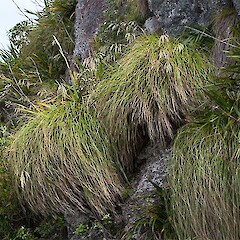Chionochloa flavicans f. temata
Common name
Te Mata Peak snow tussock
Synonyms
None (first described in 1991)
Family
Poaceae
Flora category
Vascular – Native
Endemic taxon
Yes
Endemic genus
No
Endemic family
No
Structural class
Grasses
Chromosome number
2n = 42
Current conservation status
The conservation status of all known New Zealand vascular plant taxa at the rank of species and below were reassessed in 2017 using the New Zealand Threat Classification System (NZTCS) – more information about this can be found on the NZTCS website. This report includes a statistical summary and brief notes on changes since 2012 and replaces all previous NZTCS lists for vascular plants.
Please note, threat classifications are often suggested by authors when publications fall between NZTCS assessment periods – an interim threat classification status has not been assessed by the NZTCS panel.
- Conservation status of New Zealand indigenous vascular plants, 2017 . 2018. Peter J. de Lange, Jeremy R. Rolfe, John W. Barkla, Shannel P. Courtney, Paul D. Champion, Leon R. Perrie, Sarah M. Beadel, Kerry A. Ford, Ilse Breitwieser, Ines Schönberger, Rowan Hindmarsh-Walls, Peter B. Heenan and Kate Ladley. Department of Conservation. Source: NZTCS and licensed by DOC for reuse under the Creative Commons Attribution 4.0 International licence.
2017 | At Risk – Naturally Uncommon | Qualifiers: OL
Previous conservation statuses
2012 | At Risk – Naturally Uncommon | Qualifiers: OL
2009 | At Risk – Naturally Uncommon | Qualifiers: OL
2004 | Range Restricted
Distribution
Endemic. North Island, Hawke’s Bay, where it is only known from Te Mata Peak, Havelock North.
Habitat
Confined to limestone cliffs where it can at times be locally dominant.
Detailed description
Tall, rather stout, often sprawling, flabellate tussock with persistent leaves and sheaths. Leaf-sheath to 150 mm, pinkish or purplish, chartaceous, entire, becoming fibrous, keeled, glabrous or with a few long hairs, apical tuft of hairs to 1 mm. Ligule to 0.7 mm. Leaf-blade to 750 × 8 mm, dark green, often distinctly glaucous, keeled, persistent, glabrous except for some short hairs above ligule and prickle-teeth on margins and abaxially at apex. Culm to 1.5 m, internodes glabrous. Inflorescence to 300 mm, clavate, dense and compact, not naked below; rachis smooth below, branches and pedicels densely scabrid and with some long hairs at branch axils. Spikelets of up to 4 distant florets. Glumes to 4 mm, broad, shallowly bifid, sometimes purpled, margins ciliate, prickle-teeth adaxially above, < nearest lemma lobes; lower 3-nerved, upper 5-nerved. Lemma to 4 mm, shorter and broader than typical form; hairs dense on margin, few aside central nerve, rarely reaching sinus, prickle-teeth above adaxially and abaxially on nerves; lateral lobes to 0.2 mm, conspicuously awned adjacent to a small lobe; central awn to 6 mm, reflexed, column absent. Palea to 4.5 mm, interkeel with a few short hairs. Callus to 1.5 mm, hairs to 4 mm. Rachilla to 0.25 mm. Lodicules to 1 mm. Anthers to 4 mm. Ovary to 1 mm; stigma-styles to 3 mm. Seeds to 3 mm.
Manaaki Whenua Online Interactive Key
Similar taxa
Very closely related to C. flavicans Zotov. f. flavicans from which it differs by its smaller over all floret dimensions, more compact growth habit, and leaves which are often distinctly blue-tinged.
Flowering
September–November
Fruiting
November–May
Propagation technique
Unlike its close relative C. flavicans f. flavicans, f. temata has proved to be rather slow growing and often fickle in cultivation. It is an attractive plant with slightly more glaucous leaves that f. flavicans, and so well worth trying to grow.
Threats
A narrow range limestone endemic, naturally confined to a localized limestone outcrop where it is one of the more common species present.
Etymology
chionochloa: Snow grass
Where To Buy
Occasionally offered by specialist native plant nurseries.
Attribution
Description modified from Edgar and Connor (2000).
References and further reading
Edgar E, Connor HE. 2000. Flora of New Zealand. Vol. V. Grasses. Christchurch, Manaaki Whenua Press. 650 p.
NZPCN Fact Sheet citation
Please cite as: de Lange, P.J. (Year at time of access): Chionochloa flavicans f. temata Fact Sheet (content continuously updated). New Zealand Plant Conservation Network. https://www.nzpcn.org.nz/flora/species/chionochloa-flavicans-f-temata/ (Date website was queried)







